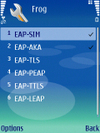Now that 3G systems such as UMTS are under full deployment, the industry is looking forward to what comes next. While some say that WiMAX is a 4G system, the IEEE and the WiMAX forum think that 802.16e is rather a 3G technology and have asked the ITU (International Telecommunication Union) to include this standard into its IMT-2000 specification (International Mobile Telecommunications 2000). This specification is generally accepted as being the umbrella defining which standards are to be considered 3G.
This is mainly a political move since in many regions of the world, frequencies are reserved for 3G IMT-2000 systems. If WiMAX were included in IMT-2000, and it looks like it will be in the near future, some frequency bands such as the 2.5 GHz IMT-2000 extension band in Europe could be used for WiMAX without changing policies.
So what remains for IMT-Advanced, the ITU umbrella name for future 4G technologies?
Currently there is still no no clear definition by ITU of the characteristics of future 4G IMT-Advanced systems. The ITU-R M.1645 recommendation gives first hints but leaves the door wide open:
It is predicted that potential new radio interface(s) will need to support data rates of up to approximately 100 Mbit/s for high mobility such as mobile access and up to approximately 1 Gbit/s for low mobility such as nomadic/local wireless access, by around the year 2010 […]
These data rate figures and the relationship to the degree of mobility (Fig. 2) should be seen as targets for research and investigation of the basic technologies necessary to implement the framework. Future system specifications and designs will be based on the results of the research and investigations.
When WiMAX is compared to the potential requirements above it’s quite clear that the current 802.16e standard would not qualify as a 4G IMT-Advanced standard since data rates even under ideal conditions are much lower.
3GPP’s Long Term Evolution (LTE) project will also have difficulties fulfilling these requirements. Even with the recently proposed 4×4 MIMO, data rates in a 20 MHz carrier would not exceed 326 MBit/s. And that’s already a long stretch since putting 4 antennas in a small device or on a rooftop will be far from simple in practice. If WiMAX is accepted as a 3G IMT-2000 technology, how can LTE with a similar performance be accepted as a 4G IMT-Advanced technology?
Additionally, one should also not forget that IMT-2000 systems such as UMTS are still evolving. UMTS is a good example. With HSDPA and HSUPA, user speeds now exceed the 2 MBit/s which were initially foreseen for IMT-2000 systems. But development hasn’t stopped here. Recent new developments in 3GPP Release 7 and 8 called HSPA+, which will include MIMO technology and other enhancements, will bring the evolved UMTS technology to the same capacity levels as what is currently predicted for LTE on a 5 MHz carrier. HSPA+ is clearly not a 4G IMT-Advanced system since it enhances a current 3G IMT-2000 radio technology. Thus, HSPA+ categorized as a ‘enhanced IMT-2000 system’.
Maybe that’s the reason why the IEEE 802.16 working group is already looking forward and has started work on 802.16m with the stated goal of reaching top speeds of 1 GBit/s.
When looking at current research it’s clear that the transmission speed requirements described in ITU-R M.1645 can only be achieved in a frequency band of 100+ MHz. This is quite a challenge since such large bands are few. Thus, I have my doubts whether these requirements will remain in place for the final definition of 4G IMT-Advanced.
Does It Really Matter If A Technology Is 3.5G, 3.9G or 4G?
While discussions are ongoing the best one can do is to look at HSPA+, WiMAX, LTE and other future developments as "Beyond 3G" systems. After all, from a user point of view it doesn’t matter if a technology is IMT-2000, Enhanced IMT-2000 or IMT-Advanced as long as data rate, coverage and other attributes of the network can keep up with the growing data traffic.
A whitepaper produced by 3G Americas has some further thoughts on the topic.
As always, comments are welcome!
